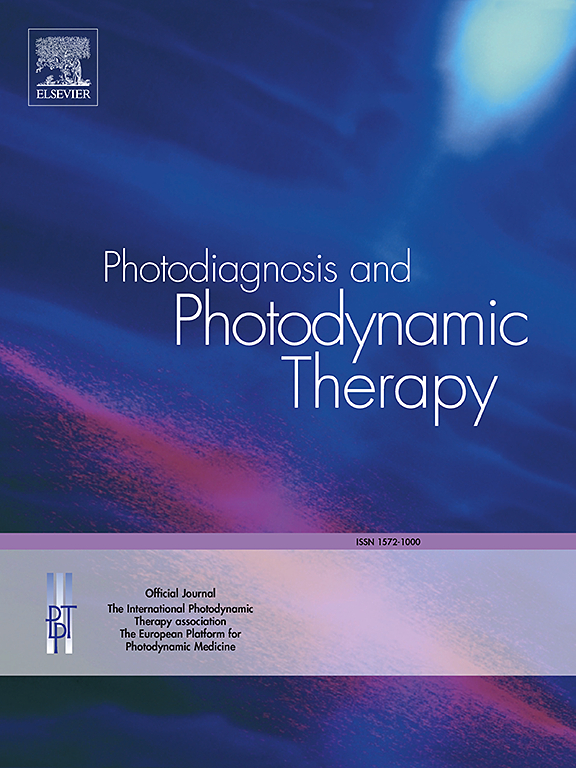Effects of photobiomodulation therapy with 808 nm diode laser on the expression of RANKL and OPG genes in exosomes isolated from MG63 osteoblast-like cells: An in-vitro study
IF 3.1
3区 医学
Q2 ONCOLOGY
引用次数: 0
Abstract
Background and aim
This study assessed the effects of 808 nm diode laser on the gene expression of receptor activator of nuclear factor kappa beta ligand (RANKL) and osteoprotegerin (OPG), key regulators of bone remodeling, in exosomes derived from osteoblast-like cells.
Materials and methods
The cultured MG63 cells were subjected to 808 nm diode laser irradiation at energy densities of 3 J/cm², 6 J/cm², and 9 J/cm², along with a control group with no intervention. The irradiation sessions were conducted twice, with a 24-hour interval between them. Next the exosomes from the target cells were isolated, and the mRNA levels of the RANKL and OPG genes were assessed using qPCR.
Results
The OPG mRNA level in exosomes extracted from cells exposed to 9 J/cm² was found to be significantly elevated compared to both the control group and 6 J/cm². Conversely, the mRNA level of RANKL in group exposed to 9 J/cm² was significantly reduced in comparison to the control group and 6 J/cm². Additionally, the RANKL mRNA level in 6 J/cm² was also significantly lower than that observed in the control group and 3 J/cm².
Conclusion
Using 808 nm diode laser at an energy density of 9 J/cm² resulted in an upregulation of exosomal mRNA for OPG and a downregulation of RANKL. Photobiomodulation may enhance bone regeneration via exosomal signaling. Considering the promising clinical application of exosomes in bone regeneration, our results highlight the potential of photobiomodulation to manipulate exosomal content for therapeutic purposes.
808 nm二极管激光光生物调节治疗对MG63成骨样细胞外泌体RANKL和OPG基因表达的影响
背景与目的:研究808 nm二极管激光对成骨样细胞外泌体中骨重塑关键调控因子核因子受体激活因子配体(RANKL)和骨保护素(OPG)基因表达的影响。材料与方法:培养的MG63细胞分别接受能量密度为3 J/cm²、6 J/cm²和9 J/cm²的808 nm二极管激光照射,并设对照组,不进行干预。照射两次,间隔24小时。然后从靶细胞中分离外泌体,使用qPCR检测RANKL和OPG基因的mRNA水平。结果:与对照组和6 J/cm²相比,暴露于9 J/cm²的细胞中提取的外泌体中OPG mRNA水平显著升高。相反,9 J/cm²处理组RANKL mRNA水平显著低于对照组和6 J/cm²处理组。6 J/cm²的RANKL mRNA水平也显著低于对照组和3 J/cm²。结论:在能量密度为9 J/cm²的808 nm激光照射下,外泌体OPG mRNA表达上调,RANKL表达下调。光生物调节可通过外泌体信号传导促进骨再生。考虑到外泌体在骨再生中的临床应用前景,我们的研究结果强调了光生物调节控制外泌体含量以达到治疗目的的潜力。
本文章由计算机程序翻译,如有差异,请以英文原文为准。
求助全文
约1分钟内获得全文
求助全文
来源期刊

Photodiagnosis and Photodynamic Therapy
ONCOLOGY-
CiteScore
5.80
自引率
24.20%
发文量
509
审稿时长
50 days
期刊介绍:
Photodiagnosis and Photodynamic Therapy is an international journal for the dissemination of scientific knowledge and clinical developments of Photodiagnosis and Photodynamic Therapy in all medical specialties. The journal publishes original articles, review articles, case presentations, "how-to-do-it" articles, Letters to the Editor, short communications and relevant images with short descriptions. All submitted material is subject to a strict peer-review process.
 求助内容:
求助内容: 应助结果提醒方式:
应助结果提醒方式:


